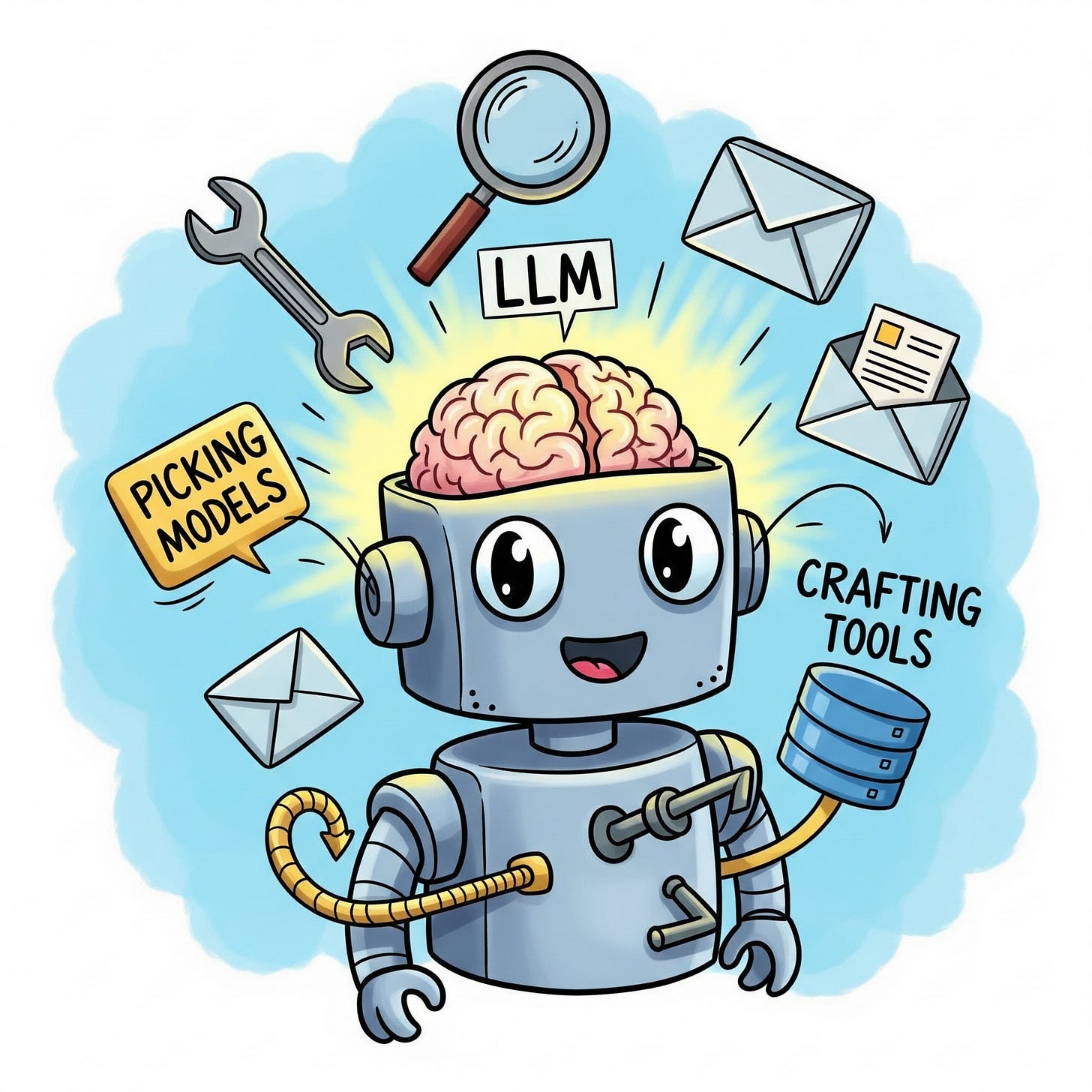Summary: Your Blueprint for Smart Agents
Ready to get hands-on? Part 2 is all about the foundational pieces that make an AI agent truly smart and capable. We're talking about choosing the right brain for your agent—the Large Language Model (LLM)—and then giving it the "hands" to actually do things in the real world through well-defined tools. Getting these two elements right is like setting a solid foundation for any amazing building.
Picking Models & Crafting Tools – The Agent's Secret Ingredients
Alright, welcome back, future agent builders! In Part 1, we chatted about what AI agents are and why they’re such game-changers. Now, let’s roll up our sleeves and talk about how we actually build these clever critters. It all starts with two absolutely crucial elements: picking the right "brain" and then giving it the "hands" to go out and get things done.
The Agent's Brain: Choosing Your LLM Model Wisely
You know, every superhero needs a unique power, right? Well, for an AI agent, that core power comes from its Large Language Model, or LLM. This is the brain that handles all the complex reasoning, understanding your instructions, and figuring out the best next step. But here’s a little secret: not all LLMs are created equal.
Some LLMs are absolute geniuses at super complex tasks, like dissecting intricate legal documents or crafting poetic verses. Others are leaner, faster, and more cost-effective for simpler, more straightforward jobs. Think of it like this: you wouldn't necessarily use a supercomputer to balance your checkbook, right? Similarly, you'll want to pick an LLM that matches the complexity of the tasks your agent needs to handle.
A good strategy? Start with a really capable model during the prototyping phase. It helps you get a feel for what’s possible. Then, once you’ve nailed down the core functionality, you might swap in a smaller, more optimized model to save on costs and speed things up, as long as it still delivers the results you need. It’s all about finding that sweet spot between capability and efficiency.
Giving Them Hands: Defining and Utilizing Tools
Okay, so your agent's got a brilliant brain. But what’s a brain without the ability to act? That’s where tools come in. Think of tools as the agent’s connection to the outside world, its ability to use external functions, interact with apps, or tap into APIs. Without tools, your agent is just a very smart chatbot; with them, it becomes a doer.
Defining these tools properly is paramount. Imagine trying to use a screwdriver without knowing what its head looks like! Each tool needs clear, standardized definitions so your agent knows exactly how and when to use it. And you know what's really cool? Tools come in different flavors, each with a distinct purpose:
Data Tools: These are for information gathering. Need to pull data from a database? Check a CRM record? Read a specific document? Or maybe even search the vast ocean of the internet? Data tools are your agent's researchers. They help the agent gather all the context it needs to make informed decisions.
Action Tools: Once your agent has figured things out, it often needs to do something. These are the tools for action! Sending an email, updating a record in a system, generating a report, or even handing off a task to a human colleague – that’s where action tools shine. They empower your agent to manipulate its environment.
Orchestration Tools: This one's a bit meta, but totally fascinating. Sometimes, an agent itself can be a tool for another agent! Imagine a "master" agent delegating a complex sub-task to a specialized "sub-agent." That’s orchestration at play, allowing for incredibly sophisticated, multi-layered workflows.
The Magic Behind the Scenes: Tool Calling Mechanisms
So, how does an agent actually decide which tool to use and how to use it? This is where tool calling mechanisms come in. It’s the behind-the-scenes magic that allows the agent to pick the right "hand" for the job. The LLM, based on its reasoning and your instructions, determines which tool (or sequence of tools!) is needed to achieve the task. It then calls that tool, passes in the necessary information (parameters), and processes the output it gets back.
This process needs to be robust, almost like a reliable supply chain. If the tool calling mechanism is shaky, your agent might pick the wrong tool, provide incorrect inputs, or stumble when interpreting the results. Getting this right ensures your agent can fluidly perform complex tasks by chaining together various tool interactions accurately and efficiently. It’s the foundation for your agent to truly excel.
Conclusion: Foundations for a Functional Friend
Alright, you've now got a solid grasp on the essential building blocks of any AI agent: understanding how to select the right LLM brain and equipping it with the right tools to act effectively. Think of it like assembling the core machinery before you start adding all the bells and whistles. Mastering these foundational elements is absolutely critical for building agents that are not just smart, but also genuinely functional and reliable.
As you can see, it's not just about having a powerful LLM; it's about integrating it seamlessly with the capabilities it needs to interact with the world. Next up, in Part 3, we'll start putting these pieces together into actual agent architectures and workflows, showing you how these brains and tools combine to create truly dynamic systems!


